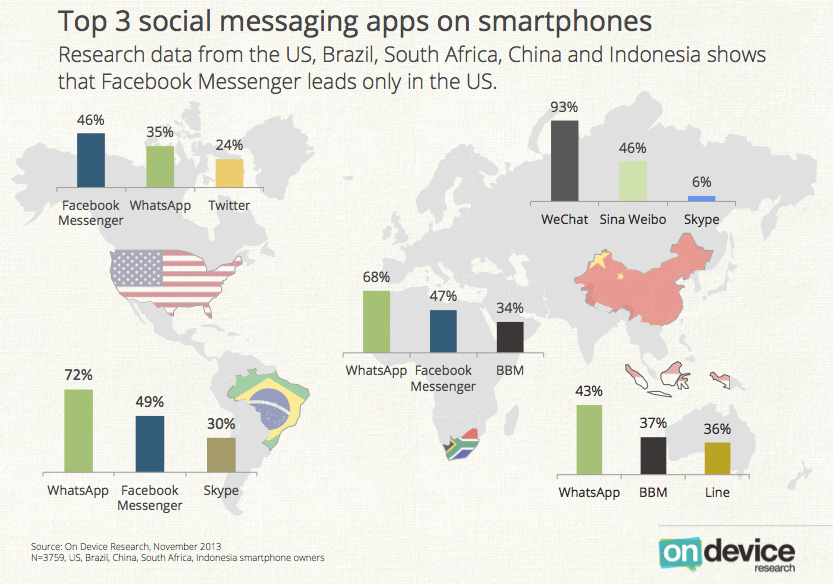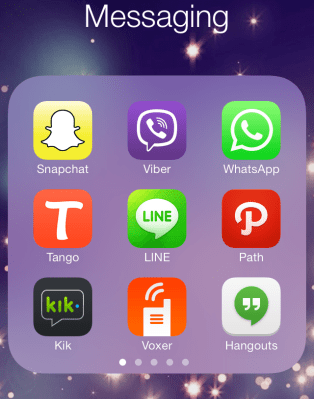Because I’ll install almost any app on my iPhone just to take a look, I’ve got a jam-packed folder called “messaging apps” that’s now five pages deep. It includes only the big names, regional giants, and those newer arrivals buzzy enough to secure coverage on TechCrunch or other tech blogs. You know, recently.
The situation is getting out of hand.
There’s no doubt that the mobile messaging phenomenon is blowing up, and everyone wants a piece of that. Analysts at Ovum last month estimated that the number of messages sent on these types of apps will grow from 27.5 trillion this year to 71.5 trillion by the end of 2014. Said the report, social messaging is “not just a fad,” but a service that will “be around in the long-term.”
“Developers,” they may have well said, “start your engines.”
Elsewhere, there are reports of messaging clients like Whatsapp overtaking Facebook Messenger, as Facebook admits to declining teen usage. There are rumors of Snapchat turning down a $3 billion acquisition offer (Maybe).
But even if mobile messaging itself is not a fad, a lot of the current products being released into the App Store today are.
 Too many otherwise talented people are building messaging apps or Snapchat alternatives with only slightly improved or differentiated feature sets. Worse, they’re building messaging app gimmicks. An app for winking selfies? It’s enough to genuinely fear for future generations.
Too many otherwise talented people are building messaging apps or Snapchat alternatives with only slightly improved or differentiated feature sets. Worse, they’re building messaging app gimmicks. An app for winking selfies? It’s enough to genuinely fear for future generations.
Nearly every day, PR staff hastily hired by developers capable of throwing together a little iOS code send out pitch after pitch about the latest and greatest messaging service – a deluge, where the words begin to blur together and descriptions almost sound copied and pasted from the app that came before it…as in, last week.
Did you see?, they write. [Redacted] is the most secure private texting app available. [Redacted] lets you safely and easily share private messages, make calls, share photos and videos! Everything is private!
Hmm, that sounds familiar.
Some try to zero in on a small feature Snapchat lacks, and make that the basis for their existence. Others pick a single function, turn that into an entire app, hoping to be the next new gimmick, a la FrontBack’s dual-photos. This one does GIFs! This one sends songs! This one too! This one has games! This one lets you post selfies! (Oh, wait. They all do that.)
Dozens of little offshoots of the messaging app vine have sprung up, slapping on a few extra features and crossing fingers. Let them come, plead app creators post-crapshoot. Let the users come.
What Johnny-come-lately doesn’t understand is that mobile messaging is not an overnight sensation, and true viral success is rare. The landscape has been dotted with messaging players for years, and only now as smartphones are hitting critical mass in key, mature markets while emerging markets like China and India adopt mobile in large numbers, are we seeing the result of what having that previously established footprint looks like.
Whatsapp, for instance, was founded in 2009 and steadily grew its user base by targeting the top charts on the App Store repeatedly by periodically dropping from a paid app to a free one, allowing it to benefit from the rush of new users snagging it on sale as it hit the top free apps list. This year, it finally felt well enough established as one of the top contenders to go free, and currently it sits in spot #28 on the U.S. App Store eating up more downloads.
Meanwhile, many of the larger messaging apps touting their incredible numbers have benefited from a regional focus, like KakaoTalk, LINE, WeChat and others. They later expanded worldwide through users’ personal networks of family and friends.

And as for popular, newer arrivals, there’s a bit of good timing and luck involved. Snapchat, for instance, grew virally in L.A. high schools – luckily for the company, which was before struggling to attract users. They almost accidentally stumbled into an addressable and underserved market than only a few years ago wouldn’t have existed: young teens with expensive smartphones, trying to avoid their parents ‘likes’ on Facebook.
The app is clever, sure, but disappearing messages was not a new idea when it arrived (which is kind of funny, given the legal fight over who came up with the idea for Snapchat). For example, in early 2010, an iPhone app called TigerText claimed it would disappear texts from users’ phones. Before that, a number of online sites let users send private texts from web to phone. Snapchat, as it turned out, was actually a repurposed idea that hit the right group of students at the right time and then took off.
But to optimistic (or perhaps naive) app publishers, the Snapchat story looks like a formula for their own viral success. Build an app for the kids, pitch its private nature…profit. It’s not that simple, of course.
And as more developers release half-baked attempts to ride the coattails of the larger messaging wave, the today still-positive vibe for newer mobile messaging experiences could turn into frustrations. These apps don’t talk to each other, after all, and each one wants you to re-create your social graph upon first sign up. Some even go so far as to hack your address book to do so. How many times can users be burned? How many times do we have to invite friends to join? How many times can we try every silly little goof, before saying “forget this, I’m going back to iMessage/Kik/Snapchat/Whatsapp/etc.” for good?
And really, how many mobile messaging apps does one person need? One? A half-dozen? More?
If mobile messaging is becoming the social networking of the 2010s, then it looks like we’re about to find out.
